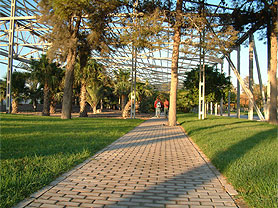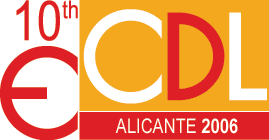
Conference Site
Pre-conference registration and tutorials will take place on September 17th at the University Venue in Alicante (Avenida Ramón y Cajal, 4). All other events (Monday to Friday) will be in the Campus of the University of Alicante at San Vicente del Raspeig (7 km outside Alicante). A bus from the city centre to the conference and back is planned.
Bus-service:
Departure: Meliá Hotel at 8:30 am.
Return: Aulario General 2, after last session ends.
The venue in Alicante is a 19th century building, the former Trading School, near the city harbour and Parque de Canalejas (see map)
On Monday 18th the conference desk will move to the Aulario General 2 building. This building is a large white semicircular building (see n.30 in the Campus map). Main conferences will take place at the Salon de Actos in the same building.
About Alicante
Local Information
The
event will take place at the University of Alicante. The University of Alicante
has a successful tradition as a site for international conferences and meetings.
The university campus has a reputation for its open spaces, gardens and modern
architecture. Although the campus can be accessed by public transportation and
 has free parking places, in order to facilitate the access from and to the city
center, a shuttle service will be arranged for the participants.
has free parking places, in order to facilitate the access from and to the city
center, a shuttle service will be arranged for the participants.
Alicante is a tourist city with a large variety of accommodation facilities. It is very well connected by plane (L'Altet Airport), train (high-speed trains to Barcelona and Madrid) and car (highway AP7 is connected to the European net of highways). September is a warm month in Alicante (typical temperatures range from 22 to 28 ºC), especially suited for outdoor activities such as walking, swimming or sailing. The city has a 900m long beach of fine golden sand.
For further information about Alicante, please have a look at:
- Patronato Municipal de Turismo - Local Tourism Board
- Aeropuerto de Alicante - Alicante Airport
- RENFE - Train Station
- Dirección General de Tráfico - Traffic General Direction
- Instituto Nacional de Meteorología - National Institute of Meteorology
- Ayuntamiento de Alicante - City Council of Alicante
- Diputación de Alicante
- Web oficial del turismo de la Comunidad Valenciana - Official Tourism Site of the Land of Valencia
History of Alicante
The area around Alicante has been inhabited for over 7000 years, with the first tribes of hunter gatherers moving down gradually from Central Europe between 5000 and 3000 BC. By 1000 BC Greek and Phoenician traders had begun to visit the eastern coast of Spain, establishing small trading ports and introducing the alphabet, iron and the pottery wheel to the native Iberian tribes. The Greeks established the fortified settlement of Akra Leuke (white peak) in 324 BC. In 201 BC the Romans, who ruled up Iberia for over 700 years, took the town and name it Lucentum.
By the fifth century Rome was in decline, and Alicante was more or less under the control of the Visigoths.
Neither the Romans nor the Goths showed much resistance to the Moorish occupation of the area, which brought oranges, rice, palms and the gifts of Islamic art and architecture. The Moors ruled Alicante (Al-Laqant in Arabic) from 718 until 1248.
The present city of Alicante stands on the medieval Moorish location, on the slopes of Mount Benacantil, where the Castillo de Santa Bárbara stands, from the slope to the beach.
The strategic location and the trade activity of the town made of Alicante a port city in the 12th century, with two routes: the Mediterranean and the Atlantic ones.
Alicante was finally taken in 1246 by the Castillian Prince Alfonso (who afterwards became King Alfonso X el Sabio), at the Reconquest, where the Christian kingdoms took the control of the Muslim ruled areas, who finally left Spain for North Africa in 1492. The town was expanded (up to the Rambla) and the castle was fortified and after Muslims had been expelled, the town was populated by northern Spanish Christian people.
During the 15th century, Alicante enjoyed
a rich period and became a major Mediterranean trading station exporting rice,
wine, olive oil, oranges and wool.
There were important architectural changes, population growed and Alicante
got the status of city by the Catholic Monarchs.
From this period are la Casa del Consell, la Montañeta quarter, San Roque, la Casa del Rey or the plaza Gabriel Miró.
In the late 17th century, the whole city was destroyed by French, and it had to be built all over again, including the Casa Consistorial (Town Hall) and the city walls.
After the War of Spanish Succession (early 18th century, the King Felipe V withdrew the semi-autonomous status Alicante had enjoyed since the Reconquest. Alicante went into a long, slow decline, surviving through the 18th and 19th centuries. Civil building from this period was the wheat warehouse (today the Museum La Asegurada).
In the 19th century, Castillo San Fernando was built to protect the new parts of the city.
By the early 20th century, industry was the main activity in the city. The whole of Spain was in a very unsteady situation, leading to the Spanish Civil War, with a subsequent economic depression.
In the sixties, there was an important economic and demographic development. The economy is now mainly based on tourism and services. Alicante is the Valencia region's second-largest town and the sixth-largest one in Spain.
Things to see
Alicante's most striking feature is the Castillo de Santa Bárbara (tel 96-516-21-28/ (96) 526 31 31; admission free; open 9am-6.30pm daily Oct-Mar, 10am-7.30pm daily Apr-Sept) sitting high at the top of Monte Benacanti (166 m high).
To reach Castillo de Santa Bárbara, you can walk up from the Hotel Maya or take the elevator (€2.40 return) which is accessed across from the information office at Playa del Postiguet.
Although remnants from the Bronze Age have been found here, the fortress itself dates between the 9th and 16th centuries. It had a strategic value, since the bay and the surroundings of Alicante are seen from the top.
The castle of the Mount "Banu-lQatil" (Benacantil) is named Santa Bárbara because Alicante was taken by the King to be Alfonso X el Sabio to the Moors on December 4th, 1248, on the day Saint Barbara’s feast is celebrated.
Inside is the Colección Capa, a large exhibit of contemporary Spanish sculpture. Many works stand outside, with the Mediterranean as a dramatic backdrop.
The MARQ Museo Arqueológico Provincial de Alicante (tel 96-514-90-00, Plaza Doctor Gómez Ulla; admission €6; open 10am-2pm/4pm-6pm Tues-Sat Oct-May, 10am-8pm Tues-Sat Jun-Sept, 10am-2pm Sun/holidays all year) will leave you spellbound. The magical display of lights, shadows, sounds and interactive images surrounds Islamic treasures, Iberian ceramic arts and Roman artefacts. It's best reached by buses numbers 02, 20 and 23. Inquire about visiting Lucentum, the Ibero-Roman City.
Built in the XIII century on the the site of a mosque, the Iglesia de Santa María (tel 96-521-60-26, Plaza de Santa María) is the oldest church in the town of Alicante. Restored in 2003-2005, the façade is entirely Baroque.
Right at the foot of Santa Bárbara Castle you find the beach of Postiguet.
Directly in front Plaza Puerta del Mar we enter a little road which brings us to the Plaza del Ayuntamiento (Town Hall square). Alicante’s Town Hall was originally built in 1688. After being heavily damaged by the French it was rebuilt in the 18th century. Lined by two 35 metre tall towers, the stairs of Town Hall represent “Cero-Point” sea level in Alicante. All measurements of height in Spain refer to this “Cero-point” as the base for their calculations. Within the Town Hall you can visit the blue salon with its wonderful mirror gallery. After passing Town Hall and to the right you will find the Plaza de Santísima Faz, a lovely little area surrounded by palm trees.
As you walk out of the old city centre of Alicante and pass the rather modern street of Rambla de Méndez Núñez, you enter the Avenida del Teatro. There you will find Alicante’s huge theatre with massive roman style columns at the entrance. Just the right place for a pleasant evening of entertainment.
A little bit further along, there is the Nativity Scene Museum at San Agustín Street. The museum contains hundreds of different scenes and figures from all over the world.
Just around the corner from the Nativity Museum, you will find the cathedral of San Nicolás de Bari. The neighbour city of Orihuela is the residence of the bishop of the province, Alicante is a "sub-cathedral" which was granted to Alicante by Pope John XXIII in 1959. With an impressive 45 metre high blue dome the cathedral is one of the landmarks of Alicante. At one of the two entrances you will find a sculpture of the holy Nicolás done in black marble.
There are many different churches, museums and places around the old city centre.
At the Plaza de Calvo Sotelo, there is a small garden where to rest. Besides, it is the best starting point for a little shopping tour in Alicante. So after a nice “shopping-rest”, you can walk the Avenida Doctor Gadea down to the harbour area.
Next to the statue of Don Eleuterio Maisonnave, former minister of state and famous son of the city of Alicante, the Avenida guides you down to the harbour with beautiful flowers along the way.
This avenue is this kind of small street that you constantly find all around Alicante and which makes the city such a wonderful place for a walk about. The city is full of peaceful places and gardens. As we continue down Avenida Doctor Gadea we reach the harbour area again.
Finally we turn back to the area around the Plaza Puerta del Mar, where we started our walk around Alicante. Along the harbour at the Paseo Explanada de España our way takes us in between a row of palm trees and back to our beginning point.
Useful information
Tourist offices
The main office (tel 96-520-00-00, Rambla Méndez Núñez 23; open 10am-7.30pm Mon-Fri & 10am-2pm/3pm-7.30pm Sat Sept16-Jun15, 10am-8pm Mon-Sat Jun16-Sept15) is supplemented by offices at the airport, bus station, main train station, city hall and during the summer, at the Playa del Postiguet.
Medical Services & Emergency.
In case of an emergency, dial tel 112 for police, fire or ambulance. Hospital de Alicante (tel 96-593-83-00, Calle Maestro Alonso 109) is 1.6 km north of the Mercado Central.
Lost Property.
Call Objetos Perdidos (tel 96-514-99-69).
Copyright ECDL - Design by JASBAT
